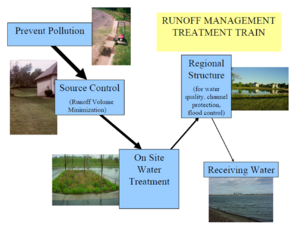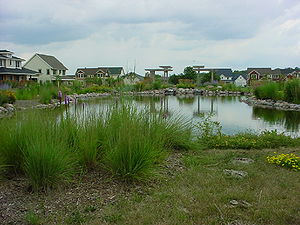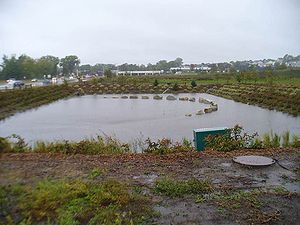
Difference between revisions of "Stormwater management for lake protection and restoration"
m |
m (→Links) |
||
| (11 intermediate revisions by the same user not shown) | |||
| Line 6: | Line 6: | ||
==Overview of phosphorus and urban stormwater runoff== | ==Overview of phosphorus and urban stormwater runoff== | ||
| − | Sources of phosphorus in urban stormwater include but are not limited to tree and lawn debris (e.g. leaves, grass clippings), fertilizers, atmospheric deposition, automobile exhaust, soil erosion, animal waste, road salt, and detergents. The relative contribution of these sources varies with location and is affected by factors such as tree cover and soil type. [[Event mean concentrations for total phosphorus|Phosphorus concentrations]] vary with land use but are commonly in the range of 0.25 to 0.35 micrograms per liter ([ | + | Sources of phosphorus in urban stormwater include but are not limited to tree and lawn debris (e.g. leaves, grass clippings), fertilizers, atmospheric deposition, automobile exhaust, soil erosion, animal waste, road salt, and detergents. The relative contribution of these sources varies with location and is affected by factors such as tree cover and soil type. [[Event mean concentrations for total phosphorus|Phosphorus concentrations]] vary with land use but are commonly in the range of 0.25 to 0.35 micrograms per liter ([https://apps.dtic.mil/sti/pdfs/ADA430436.pdf Lin], 2004). Annual phosphorus export is a function of runoff volume and will be greater in areas with high percentages of impervious cover and soils that have low infiltration rates. Loehr (1974) and Lin (2004) provide reviews of phosphorus export from urban areas. The median phosphorus export from the Loehr study was about 0.8 pounds per acre per year, but the coefficient of variation was about 1.8. |
| − | A presentation by [ | + | A presentation by [https://www.wrri.msstate.edu/pdf/perry09.pdf Perry et al.] (2009) provides an overview of phosphorus in urban stormwater. Although this document provides information for the Chesapeake Bay watershed and includes extraneous information related to stormwater management in that watershed, the general information on phosphorus in urban stormwater is comprehensive and generally applicable to all urban stormwater. |
==BMP selection== | ==BMP selection== | ||
| Line 20: | Line 20: | ||
The basic premise for selection of a Best Management Practice (BMP) or group of BMPs is to follow the treatment train approach. Under the treatment train approach, stormwater management begins with simple methods that minimize the amount of runoff that occurs from a site and methods that prevent pollution from accumulating on the land surface and becoming available for wash-off. Even though we know that we will never be able to fully accomplish either of these goals, we can make substantial progress using the [[Better site design|Better Site Design]], Low Impact Development (LID), [[Pollution prevention|pollution prevention]], volume minimization, and [[Temporary construction erosion and sediment control|temporary construction erosion and sediment control]] techniques. | The basic premise for selection of a Best Management Practice (BMP) or group of BMPs is to follow the treatment train approach. Under the treatment train approach, stormwater management begins with simple methods that minimize the amount of runoff that occurs from a site and methods that prevent pollution from accumulating on the land surface and becoming available for wash-off. Even though we know that we will never be able to fully accomplish either of these goals, we can make substantial progress using the [[Better site design|Better Site Design]], Low Impact Development (LID), [[Pollution prevention|pollution prevention]], volume minimization, and [[Temporary construction erosion and sediment control|temporary construction erosion and sediment control]] techniques. | ||
| − | After all of the efforts possible are made to minimize runoff and surface wash-off, we must recognize that some potential for runoff will occur. The next major BMP then becomes collection and treatment of runoff locally and regionally, either as stand-alone practices or in treatment train combinations. Some of the available BMPs are best used to reduce runoff volume, while others focus on water quality improvement. Some BMPs will be easy to implement, while others involve serious engineering and sophisticated design. Other BMPs used in a treatment train include [[Bioretention|bioretention]] devices, filtration practices such as [[ | + | After all of the efforts possible are made to minimize runoff and surface wash-off, we must recognize that some potential for runoff will occur. The next major BMP then becomes collection and treatment of runoff locally and regionally, either as stand-alone practices or in treatment train combinations. Some of the available BMPs are best used to reduce runoff volume, while others focus on water quality improvement. Some BMPs will be easy to implement, while others involve serious engineering and sophisticated design. Other BMPs used in a treatment train include [[Bioretention|bioretention]] devices, filtration practices such as [[Dry swale (Grass swale)|dry swales]], infiltration practices such as [[Infiltration trench|infiltration trenches]] and infiltration basins, [[Stormwater ponds|stormwater ponds]] and [[Stormwater wetlands|stormwater wetlands]]. |
===Types of BMPs=== | ===Types of BMPs=== | ||
| Line 87: | Line 87: | ||
There is considerable information on pollutant removal in the literature and on-going research on the topic of pollutant removal by stormwater Best Management Practices (BMPs). The information in this manual is therefore subject to change and often reflects ranges found in the literature rather than specific values. Pollutant removal is a function of many factors, including design, construction, and maintenance of the BMP, quality of incoming stormwater, time of year, and so on. | There is considerable information on pollutant removal in the literature and on-going research on the topic of pollutant removal by stormwater Best Management Practices (BMPs). The information in this manual is therefore subject to change and often reflects ranges found in the literature rather than specific values. Pollutant removal is a function of many factors, including design, construction, and maintenance of the BMP, quality of incoming stormwater, time of year, and so on. | ||
| − | Information on pollutant removal can be found at [[Information on pollutant removal by BMPs|this link]]. Each structural BMP discussed in this Manual has an | + | Information on pollutant removal can be found at [[Information on pollutant removal by BMPs|this link]]. Each structural BMP discussed in this Manual has an article (webpage) discussing stormwater credits. Credits refer to stormwater volume or pollutant mass removed by a BMP. |
==Selecting models for urban stormwater== | ==Selecting models for urban stormwater== | ||
| Line 95: | Line 95: | ||
===Design=== | ===Design=== | ||
| − | [ | + | [https://stormwater.pca.state.mn.us/index.php?title=Category:Level_3_-_Best_management_practices/Specifications_and_details/Design_criteria Links to information on design criteria for individual BMPs] |
===Construction=== | ===Construction=== | ||
| − | [ | + | [https://stormwater.pca.state.mn.us/index.php?title=Category:Level_3_-_Best_management_practices/Specifications_and_details/Construction_specifications Links to information on construction specifications for individual BMPs] |
===Operation and maintenance=== | ===Operation and maintenance=== | ||
| − | [ | + | [https://stormwater.pca.state.mn.us/index.php?title=Category:Level_3_-_Best_management_practices/Specifications_and_details/Operation_and_maintenance Links to information on operation and maintenance for individual BMPs] |
===Assessment=== | ===Assessment=== | ||
| − | [ | + | [https://stormwater.pca.state.mn.us/index.php?title=Category:Level_3_-_Best_management_practices/Specifications_and_details/Assessing_performance Links to assessing the performance of individual BMPs] |
==References== | ==References== | ||
| − | *Lin, Jeff P. 2004. [ | + | *Lin, Jeff P. 2004. [https://apps.dtic.mil/sti/pdfs/ADA430436.pdf Review of Published Export Coefficient and Event Mean Concentration (EMC) Data]. ERDC TN-WRAP-04-3. U.S. Army Corps of engineers. Engineer Research and Development Center, Vicksburg, MS. |
*Loehr, R. C. 1974. ''Characteristics and comparative magnitude of non-point sources''. Journal of the Water Pollution Control Federation 46(8):1849-1872. | *Loehr, R. C. 1974. ''Characteristics and comparative magnitude of non-point sources''. Journal of the Water Pollution Control Federation 46(8):1849-1872. | ||
| − | *Perry, Scott. 2009. [ | + | *Perry, Scott. 2009. [https://www.imbriumsystems.com/Portals/0/documents/sm/technical_docs/Urban%20Stormwater%20Runoff%20Phosphorus%20Loading%20and%20BMP%20Treatment%20Capabilities.pdf Urban Stormwater Runoff Phosphorus Loading & BMP Treatment Capability]. Presentation at The Maryland Association of Floodplain and Stormwater Managers 5th Annual Conference. October 21-23, 2009. |
*Walker, W. 1987. [http://www.wwwalker.net/pdf/dbasins.pdf Phosphorus removal by urban runoff detention basins]. Lake and Reservoir Management. Volume III:314-326. | *Walker, W. 1987. [http://www.wwwalker.net/pdf/dbasins.pdf Phosphorus removal by urban runoff detention basins]. Lake and Reservoir Management. Volume III:314-326. | ||
==Links== | ==Links== | ||
| − | *Minnesota Pollution control Agency. [ | + | *Minnesota Pollution control Agency. [https://www.pca.state.mn.us/sites/default/files/wq-iw1-48.pdf Addressing Lakes in Watershed Restoration and Protection Strategies] |
| − | *Minnesota Pollution control Agency. [ | + | *Minnesota Pollution control Agency. [https://www.pca.state.mn.us/air-water-land-climate/lake-water-quality#:~:text=Statewide%2C%2075%25%20of%20lakes%20meet,have%20stayed%20about%20the%20same. Lakes and water quality] |
Latest revision as of 21:20, 20 February 2023
As of the end of 2012, 540 lakes in Minnesota were identified as impaired (not meeting water quality standards) for eutrophication. The impaired lakes represent 27 percent of the roughly 2,000 Minnesota lakes that have sufficient monitoring data for assessment. The nutrient responsible for these impairments is phosphorus.
Many Minnesota lakes have water quality that is substantially better than their applicable standards, especially in the north-central and northeastern parts of the state. Many other lakes meet the standards but may exhibit declining water quality. The high-quality lakes and other lakes that meet water quality standards require protection from future degradation.
This page includes information that may be useful in addressing lake protection and restoration as it relates to urban stormwater and stormwater management. Most of this information is located elsewhere in the Manual but has been pulled together to provide information specific to addressing lake protection and restoration. The discussion includes summary information on BMP selection; information on BMP design, construction, maintenance, and assessment; and information on pollutant loading and pollutant removal by different BMPs.
Contents
Overview of phosphorus and urban stormwater runoff
Sources of phosphorus in urban stormwater include but are not limited to tree and lawn debris (e.g. leaves, grass clippings), fertilizers, atmospheric deposition, automobile exhaust, soil erosion, animal waste, road salt, and detergents. The relative contribution of these sources varies with location and is affected by factors such as tree cover and soil type. Phosphorus concentrations vary with land use but are commonly in the range of 0.25 to 0.35 micrograms per liter (Lin, 2004). Annual phosphorus export is a function of runoff volume and will be greater in areas with high percentages of impervious cover and soils that have low infiltration rates. Loehr (1974) and Lin (2004) provide reviews of phosphorus export from urban areas. The median phosphorus export from the Loehr study was about 0.8 pounds per acre per year, but the coefficient of variation was about 1.8.
A presentation by Perry et al. (2009) provides an overview of phosphorus in urban stormwater. Although this document provides information for the Chesapeake Bay watershed and includes extraneous information related to stormwater management in that watershed, the general information on phosphorus in urban stormwater is comprehensive and generally applicable to all urban stormwater.
BMP selection
Designers need to carefully think through many factors to choose the most appropriate, effective and feasible practice(s) at a development site that will best meet local and state stormwater objectives. Selecting an inappropriate BMP for a site could lead to adverse resource impacts, friction with regulators if a BMP does not work as anticipated, misperceptions about stormwater control success, and wasted time and money. Careful selection of BMPs will prevent negative impacts resulting from installing the wrong BMP at the wrong location.
For more information on BMP selection, including factors affecting BMP selection and information on BMP cost, see the section describing the section that discusses the process for selecting BMPs. This section includes several matrices that can be used to select appropriate BMPs.
Stormwater treatment train
The basic premise for selection of a Best Management Practice (BMP) or group of BMPs is to follow the treatment train approach. Under the treatment train approach, stormwater management begins with simple methods that minimize the amount of runoff that occurs from a site and methods that prevent pollution from accumulating on the land surface and becoming available for wash-off. Even though we know that we will never be able to fully accomplish either of these goals, we can make substantial progress using the Better Site Design, Low Impact Development (LID), pollution prevention, volume minimization, and temporary construction erosion and sediment control techniques.
After all of the efforts possible are made to minimize runoff and surface wash-off, we must recognize that some potential for runoff will occur. The next major BMP then becomes collection and treatment of runoff locally and regionally, either as stand-alone practices or in treatment train combinations. Some of the available BMPs are best used to reduce runoff volume, while others focus on water quality improvement. Some BMPs will be easy to implement, while others involve serious engineering and sophisticated design. Other BMPs used in a treatment train include bioretention devices, filtration practices such as dry swales, infiltration practices such as infiltration trenches and infiltration basins, stormwater ponds and stormwater wetlands.
Types of BMPs
Best Management Practices can be divided into the following types.
- Pollutant minimization
- Infiltration
- Filtration and settling
- Treatment
BMPs do not always neatly fit into one of these categories. For example, a bioretention BMP with an elevated underdrain allows some water to infiltrate below the underdrain, while the remaining water is captured by the underdrain and returned to the stormwater system. this BMP therefore acts as both an infiltration and a filtration BMP. If iron is added to the bioretention media for purposes of removing phosphorus, then the BMP also acts as a treatment BMP. The final BMP design will be a function of site conditions and treatment objectives.
Pollutant minimzation BMPs
The first level of BMP application occurs at the planning stage and is intended to minimize the impact of development. These practices are intended to prevent pollution and minimize the increase in stormwater volume and are considered prior to initiation of construction or land altering activity. These practices include the following:
- Pollution prevention. Major sources of phosphorus include yard waste and litter, pet waste, illicit discharges, and sediment. Pollution prevention is an effective tool for reducing phosphorus loads from these sources. Specific recommended practices include such things as
- housekeeping, including landscaping, street sweeping, pavement maintenance, catch basin maintenance, yard waste reduction and litter control;
- animal waste management;
- streambank stabilization; and
- public works activities including chemical and sanitary wastes, and sewer maintenance.
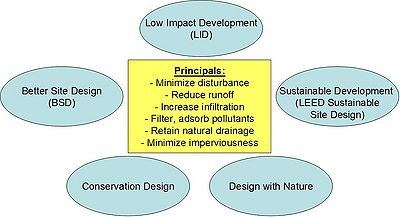
- Better site design. Better site design includes a series of techniques that reduce impervious cover, conserve natural areas, and use pervious areas to more effectively treat stormwater runoff and promote the treatment train approach to runoff management. The goal of better site design is to reduce runoff volume and mitigate site impacts when decisions are being made about proposed layout of a development site.
- Temporary construction erosion and sediment control. These practices are described in terms of perimeter, slope, drainageway and “other” criteria, and include
- vegetated buffers;
- silt fence;
- access/egress and drainage inlet protection;
- soil and slope stabilization; and
- exposed soil covers and reinforcement.
Infiltration BMPs
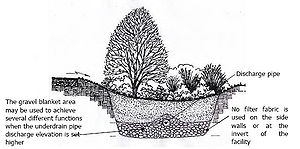
The first objective in managing stormwater runoff is to retain as much water on site as site conditions and economic considerations allow. Retaining the first inch of precipitation, or 1.1 inches if employing the Minimal Impact Design Standards performance goal for new development and redevelopment, captures about 90 percent of all rainfall events. Sizing a BMP to capture water beyond these amounts becomes more expensive with less return in terms of treatment.
Infiltration is a highly effective practice for phosphorus. Phosphorus typically has low mobility through soil and groundwater and is therefore attenuated with infiltration practices. For partial infiltration practices, such as a bioretention practice with an elevated underdrain, it is important to ensure the filter media does not leach phosphorus. Bioretention Mixes C and D are recommended for these situations. Soil amendments to attenuate iron have been shown to be very effective.
Site conditions may limit or prevent infiltration of stormwater. These include
- presence of shallow bedrock,
- presence of shallow groundwater,
- presence of karst,
- presence of soils with low or high infiltration rates,
- presence of contaminated soils or groundwater, or
- presence of stormwater with high pollutant concentrations.
Filtration and settling BMPs
Filtration and settling BMPs are both effective at removing particulate material and are therefore combined in this discussion. Neither type of BMP effectively removes dissolved phosphorus. These BMPs can therefore only remove about 50 percent of the total phosphorus load.
Filtering practices include media filters (surface, underground, perimeter), vegetative filters (filter strips, grass channels), and combination media/vegetative filters (dry swales). Media and media/vegetative filters operate similarly. Vegetative filters are generally more suitable as pre-treatment practices, but in some situations can be used on a stand alone basis. Filtering practices have widespread applicability and are suitable for all land uses, as long as the contributing drainage areas are limited.
Settling BMPs include stormwater ponds and stormwater wetlands. Generally speaking, the term stormwater pond may refer to any constructed basin that is built for the purpose of capturing and storing stormwater runoff, either temporarily or for an extended period of time, in order to prevent or mitigate downstream water quantity or quality impacts. Stormwater ponds are typically installed as an end-of-pipe BMP at the downstream end of the treatment train. However, due to their size and versatility, stormwater ponds are often the only management practice employed at a site and therefore must be designed to provide adequate water quality and water quantity treatment for all regulated storms. Stormwater wetlands are similar in design to stormwater ponds and mainly differ by their variety of water depths and associated vegetative complex. Stormwater wetlands are constructed stormwater management practices, not natural wetlands. Like ponds, they can contain a permanent pool and temporary storage for water quality control and runoff quantity control.
The effectiveness of filtration and settling BMPs in removing phosphorus varies with design. For example, stormwater ponds with appreciable residence times have been shown to remove dissolved phosphorus as a result of adsorption and plant uptake (see Walker, 1987). More information on pollutant removal rates for different BMPs and different levels of performance can be found in the section on pollutant removal by BMPs.
Chemical treatment BMPs
If infiltration practices cannot be employed, dissolved phosphorus can be removed from stormwater runoff through chemical treatment. Aluminum and iron are the two most common amendments used to remove dissolved phosphorus. Phosphorus-sorbing amendments can be used in a variety of BMPs, including bioretention, swales and sand filters. These technologies are relatively new for stormwater management but have proven effective for other applications.
Pollutant removal by BMPs
There is considerable information on pollutant removal in the literature and on-going research on the topic of pollutant removal by stormwater Best Management Practices (BMPs). The information in this manual is therefore subject to change and often reflects ranges found in the literature rather than specific values. Pollutant removal is a function of many factors, including design, construction, and maintenance of the BMP, quality of incoming stormwater, time of year, and so on.
Information on pollutant removal can be found at this link. Each structural BMP discussed in this Manual has an article (webpage) discussing stormwater credits. Credits refer to stormwater volume or pollutant mass removed by a BMP.
Selecting models for urban stormwater
Stormwater models are primarily designed to estimate pollutant and hydrologic loading with and without stormwater BMPs. A large number of models exist and these are summarized in the Manual.
BMP design, construction, maintenance, and assessment
Design
Links to information on design criteria for individual BMPs
Construction
Links to information on construction specifications for individual BMPs
Operation and maintenance
Links to information on operation and maintenance for individual BMPs
Assessment
Links to assessing the performance of individual BMPs
References
- Lin, Jeff P. 2004. Review of Published Export Coefficient and Event Mean Concentration (EMC) Data. ERDC TN-WRAP-04-3. U.S. Army Corps of engineers. Engineer Research and Development Center, Vicksburg, MS.
- Loehr, R. C. 1974. Characteristics and comparative magnitude of non-point sources. Journal of the Water Pollution Control Federation 46(8):1849-1872.
- Perry, Scott. 2009. Urban Stormwater Runoff Phosphorus Loading & BMP Treatment Capability. Presentation at The Maryland Association of Floodplain and Stormwater Managers 5th Annual Conference. October 21-23, 2009.
- Walker, W. 1987. Phosphorus removal by urban runoff detention basins. Lake and Reservoir Management. Volume III:314-326.
Links
- Minnesota Pollution control Agency. Addressing Lakes in Watershed Restoration and Protection Strategies
- Minnesota Pollution control Agency. Lakes and water quality
This page was last edited on 20 February 2023, at 21:20.
